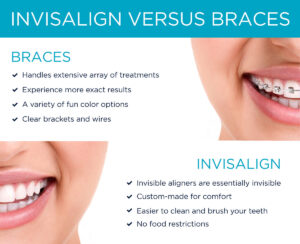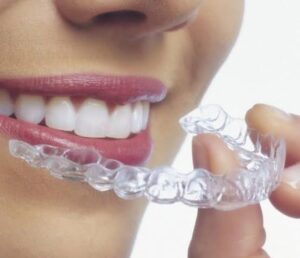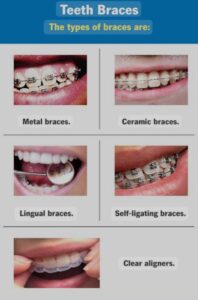
Alignment of Teeth (Braces and Invisible Aligners)
The alignment of teeth braces and invisible aligners has revolutionized orthodontic treatments. The ideal age for orthodontic consultations is approximately 8–12 years, so if any bone-related manipulation is to be considered, it is possible before the growth spurt is over.
When it comes to mal-alignment correction, there are several options, as follows:
1) Invisible Aligners
2) Lingual Orthodontics
3) Ceramic Brackets
4) Ceramic Brackets with Metal Slots
5) Metal Brackets
The entire treatment of invisible aligners is digitally planned by specialized software, which involves scanning your teeth, visualising the perfect prediction of the results, the amount of time involved for the completion of the treatment, and the number of aligners required.
These aligners are custom fabricated based on your dental scan, and the progress is monitored after every interval.
These transparent trays are almost invisible and that you are expected to remove while eating and brushing your teeth.
You have to visit the clinic as per the intervals set by us, during and after the treatment.
And because of this flexibility, it is possible to get your teeth aligned even while you are travelling or settled in a different country, which otherwise is not quite possible if you opt for brackets / braces.
The alignment of teeth plays a crucial role in oral health, functionality, and aesthetics. Misaligned teeth, known as malocclusion, can lead to issues like difficulty chewing, speech problems, and an increased risk of dental decay or gum disease. To correct these problems, orthodontic treatments such as braces and invisible aligners are commonly used.
Braces
Braces are a traditional and highly effective method for straightening teeth and correcting bite issues. They consist of brackets affixed to each tooth and connected by an archwire, which applies continuous pressure to move the teeth into the desired position over time. Modern braces come in several types:
- Metal Braces: The most common type, made of stainless steel, they are durable and cost-effective but visibly noticeable.
- Ceramic Braces: Made from tooth-colored or clear materials, these are less visible but may be more fragile.
- Lingual Braces: Attached to the back of the teeth, they are virtually invisible but can be more challenging to clean and adjust.
- Self-Ligating Braces: These use clips instead of elastic bands, reducing friction and potentially speeding up treatment.
Treatment with braces typically lasts 18 months to 3 years, depending on the complexity of the case. Braces are highly effective for severe misalignments and structural corrections.

Invisible Aligners
Invisible aligners, such as Invisalign, are a modern alternative to traditional braces. They consist of a series of clear, custom-made trays that gradually shift teeth into alignment. Patients wear each set of aligners for about two weeks before moving on to the next stage.
Benefits of Aligners
- Aesthetic Appeal: Made from transparent material, aligners are virtually invisible, making them popular among adults and teenagers.
- Comfort and Convenience: Aligners can be removed for eating, brushing, and flossing, allowing for easier maintenance of oral hygiene.
- Predictable Results: Digital scans and treatment planning provide a clear visual of the expected outcome.
However, aligners are most effective for mild to moderate cases of misalignment. Compliance is essential, as they must be worn for 20–22 hours daily for optimal results.
Choosing the Right Option
The choice between braces and aligners depends on individual needs, the complexity of the alignment, lifestyle preferences, and budget. A consultation with an orthodontist helps determine the best solution for achieving a healthy, confident smile.
Both braces and invisible aligners are transformative tools in orthodontics, promoting not only well aligned teeth but also better oral health and self-esteem.
